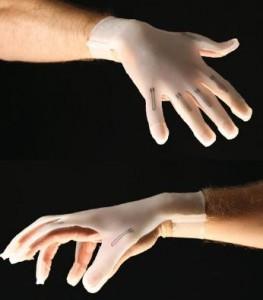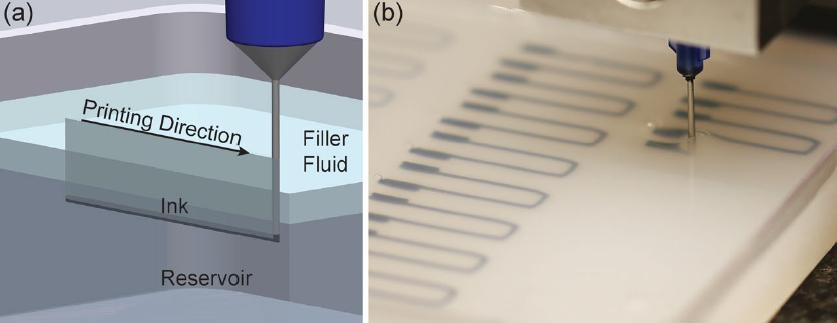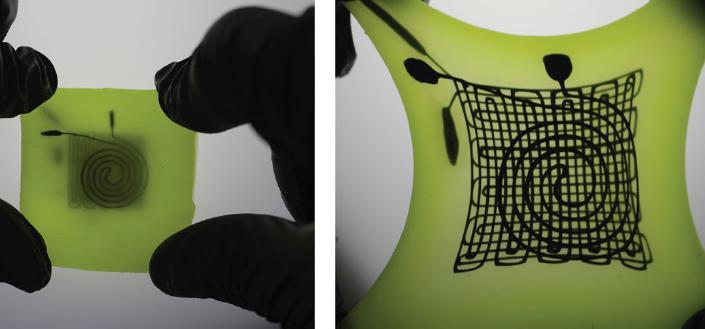It is amazing how quickly 3D printing technology has been advancing. The advancements we have seen from the time Chuck Hull invented the process of stereolithography in 1983 until the early 2000’s, pales in comparison to the progress we have seen in just the last few years. When Chuck Hull invented 3D printing, I’m sure he had no clue that today we’d be printing out sensors and other electronic devices, but that’s where exponential progress has taken us.
As wearable electronics, embeddable sensors, and soft robotics take hold over the next decade, we will need to come up with methods of producing cheap, reliable, tiny sensors and electrical components. A team of researchers, including Joseph T. Muth , Daniel M. Vogt , Ryan L. Truby , Yigit Mengüç, David B. Kolesky, Robert J. Wood , and Jennifer A. Lewis recently published a paper in ‘Advanced Materials‘, which gives such technology a tremendous boost in the right direction. The paper details a process researchers have invented, of 3D printing strain sensors into extremely stretchable elastomers.
For those who are unfamiliar with the technology, a strain sensor is a type of data collection device which can detect electrical currents, and thus the strain on an object. Such a sensor takes advantage of the fact that the electrical conductivity of an object changes as its geometry changes. A typical sensor usually sits in a coiled state when relaxed. When the object the sensor is embedded in stretches or strains, that sensor is also stretched. As it’s stretched it becomes narrower and longer, leading to a state in which its electrical resistance increases. On the contrary, if that sensor is compressed, the opposite will occur. The data captured by measuring these changes in electrical resistance allows for a measurement of strain.
In order to embed sensors into a device, the team of researchers developed a multi component materials system. The system used is composed of materials which are elastic, and chemically compatible with one another. They include a viscoelastic ink, a reservoir, and a filler fluid. The reservoir was able to facilitate a patterning of the ink, without permitting it to break up, as the nozzle printed the conductive ink into it. The filler fluid they used once the ink is printed into the reservoir was a modified, commercially available silicone elastomer called Ecoflex 00-30. The same material was also used for the reservoir itself. The configuration of the system can be seen in figure ‘a’ below. Figure ‘b’ shows a planar array of soft strain sensors which have been 3D printed.
The conductive ink used within the 3D printer is inexpensive and environmentally friendly. It is a substance known as carbon conductive grease, which is composed of carbon black and silicone oil. This ink has a strong shear-thinning response, allowing it to be extruded from a very fine nozzle (410 μm) on the 3D printer. The printer used, was custom built by Aerotech Inc, and extruded the ink from a pattern it received from G-code commands written by the researchers. To summarize the outcome of this amazing research, I will quote the paper itself:
“We report a new method for creating highly stretchable sensors based on embedded 3D printing of a carbon-based resistive ink within an elastomeric matrix. By tuning the rheological properties of the ink, reservoir, and filler fluid, mechanically robust, scalable, and complex sensor designs were fabricated. e-3DP allows for the sensor geometry and properties to be independently tuned by controlling print path and filament cross-section, respectively. Our approach opens new avenues for creating soft functional devices for wearable electronics, human/machine interfaces, soft robotics, and beyond.”
The benefits of such a production process could be huge for future manufacturing applications within the electronics industry. It will certainly be a while before we start seeing 3D printed smartphones, however, this is certainly a step towards a future where major electronics and sensors can be printed into the products we use. Let us know what you think in the 3D printed strain sensor forum thread on 3DPB.com
[Source: Advanced Materials]
Subscribe to Our Email Newsletter
Stay up-to-date on all the latest news from the 3D printing industry and receive information and offers from third party vendors.
You May Also Like
Gorilla Sports GE’s First 3D Printed Titanium Cast
How do you help a gorilla with a broken arm? Sounds like the start of a bad joke a zookeeper might tell, but it’s an actual dilemma recently faced by...
Nylon 3D Printed Parts Made More Functional with Coatings & Colors
Parts 3D printed from polyamide (PA, Nylon) 12 using powder bed fusion (PBF) are a mainstay in the additive manufacturing (AM) industry. While post-finishing processes have improved the porosity of...
$25M to Back Sintavia’s Largest Expansion of Metal 3D Printing Capacity Since 2019
Sintavia, the digital manufacturing company specializing in mission-critical parts for strategic sectors, announced a $25 million investment to increase its production capacity, the largest expansion to its operations since 2019....
Velo3D Initiates Public Offering in a Bid to Strengthen Financial Foundations and Drive Future Growth
Velo3D (NYSE: VLD) has been among a number of publicly traded 3D printing firms that have attempted to weather the current macroeconomic climate. After posting a challenging financial report for 2023,...
































